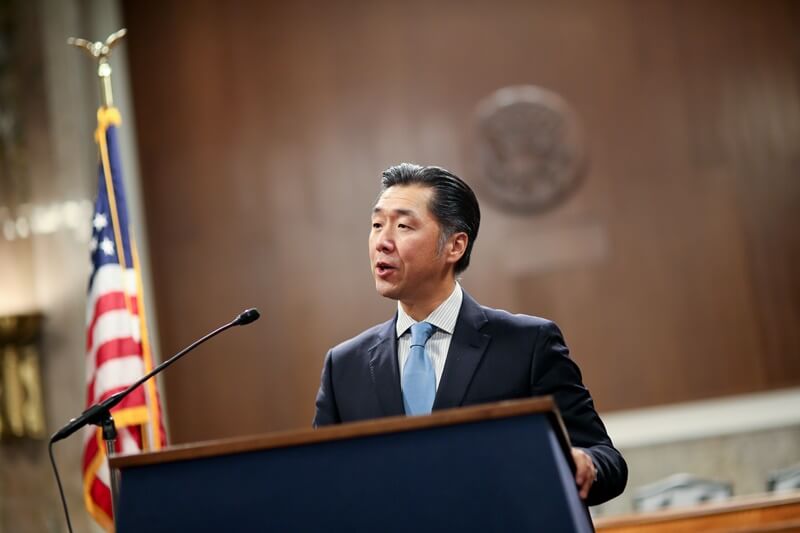Just weeks before, North Korea’s latest test of the Hwasong-15, the newest intercontinental ballistic missile, Dr. Hyun Jin P. Moon joined experts, academics, and civil society leaders at the International Forum on One Korea in Washington D.C. held at the United States Senate – Dirksen Senate Hearing Room on November 14 to fast track approaches to peaceful reunification.
Taking place at the United States Senate and Ronald Regan Building and International Trade Center in Washington D.C., the forum was co-convened by the Global Peace Foundation, East West Center, Action for Korea United and the One Korea Foundation.
Below are his remarks.
Distinguished guests, ladies and gentlemen:
Thank you for joining us at this important International Forum on One Korea, as we address the serious challenges posed by the crisis on the Korean Peninsula.
Let me thank the co-conveners and partners that have joined the Global Peace Foundation in organizing this forum, including Action for Korea United, the EastWest Institute, One Korea Foundation, and the Korean National Unification Advisory Council.
I would also like to recognize members of the Korean National Assembly, in addition to the large delegation from Korea that represents Action for Korea United (AKU). Please join me in recognizing them with a round of applause.
We welcome, likewise, the many scholars and friends from across the globe who are here today in a common pursuit of peaceful Korean unification as the enduring solution to the pressing challenge before us.
It is fitting that we meet today in the United States Capitol as we reflect on the longstanding ties of friendship between the US and the Korean people. Since the Korean War, our two peoples have shared a bond of blood, sweat and tears as well as the timeless principles and values rooted in the “inalienable rights and freedoms” given to us by our Creator.

Plenary Speakers (left to right): Dr. William Parker, Chief Operating Officer, EastWest Institute; Dr. Edwin Feulner, Founder and President, The Heritage Foundation (Photo courtesy of Global Peace Foundation)
Yet, the single-minded North Korean pursuit of a nuclear inter-continental ballistic missile program has become the most pressing issue affecting global peace and security. Addressing this urgent threat has become a top priority of US foreign policy, and has led to new levels of cooperation among nations in Asia, both allies and former adversaries.
Pyongyang’s provocations are a serious challenge to the global community, but also have presented us with an historic opportunity. To grasp that opportunity we need to look beyond the denuclearization challenge and view Korea in a broader historical context.
We must recall that the division of the Korean peninsula arose out of the geopolitics of the Cold War and had nothing to do with the aspirations of the Korean people. That aspiration was to create a model nation, which espoused fundamental human rights and freedoms unique to the historic and cultural experiences of Korea. It was expressed most fully during the Sam-Il (March 1) independence movement of 1919 but was thwarted and left unfulfilled throughout the 20th century. But those dreams have not died.
With the world’s attention focused on the peninsula, the time is ripe to pursue an “endgame” strategy for the peaceful unification of Korea once and for all. All interim issues such as denuclearization would be addressed within that framework. Its achievement would guarantee global peace and security, opening the door to prosperity in the region and worldwide. Most of all, it will fulfill the first step in realizing the Korean Dream of creating a model nation among nations and poise the Korean people on the threshold of fulfilling their national destiny.
Korean Dream
Such an approach is articulated in my 2014 book, Korean Dream, which outlines a vision for Korea’s future, rooted in its unique history and culture. I believe it was the first treatise on unification that dealt with the issue from a historic and philosophical perspective and challenged many assumptions that had dominated academic and policy circles. It articulated the historic aspirations of the Korean people rooted in its founding mythology five thousand years ago. It showed how that aspiration shaped Korean history, culture, identity and sense of national destiny and how it could develop into a dream that could unite all Koreans, even those in the North and South.
Ladies and gentlemen, we should not underestimate the impact and motivating power of a dream.
I open the first chapter of my book with a quote by Genghis Khan: “If one person has a dream, it is just a dream, but if all people have that dream, it becomes reality.” From the outset, I knew that the confrontational nature of the Cold War framework would be a non-starter in seeking peaceful unification. What was needed was a unifying dream that was uniquely Korean, without the taint of foreign influence and intervention.
All free, ethical, and prosperous nations are grounded in universal principles that undergird their liberty and define our common humanity; these are transcendent truths that various cultures have described in their own way.
For Americans, they are expressed in the Declaration of Independence, enshrining the principles that President Lincoln drew upon to challenge and finally abolish the institution of slavery through the Civil War and that the civil rights activist Martin Luther King Jr. harkened to in his landmark “I Have a Dream” speech.
In my native Korea, these principles are embodied in an ideal that has been cherished for millennia known as “Hongik Ingan” which calls the Korean people to fulfill a destiny of living for the benefit of all humanity. Throughout Korean history, the Hongik Ingan ideal has served as a touchstone of aspiration, principles and values that shaped the spiritual consciousness of the Korean people and guided them in times of crisis.
Koreans, today, need to draw upon this common ideal that long predates the conflicting ideologies since 1945. It alone provides the basis of a shared destiny and cultural values that formed the unique Korean identity and, thereby, has the power to rejuvenate it. It is the only guiding vision that has the historic and cultural legitimacy to bridge the ideological, political, economic and national divides on the peninsula and build a peaceful future for all Koreans.
Korean Self-determination from the Roots
Korean history did not begin in 1945, with the collapse of Japan. Before it was absorbed into the larger Japanese Empire during the turn of the 20th century, it was an ancient civilization with a history that spanned five millennia.
With the end of WWII, the two dominant world powers, the United States and the Soviet Union, divided the peninsula into zones of influence propping up their client regimes in the South and North, respectively. The division was never meant to be permanent, but a temporary “stop gap” measure until national elections in 1948. Those elections were never held.
Instead, two separate Korean governments were established that reflected the ideological divide between the US and the USSR. The Korean War was the product of the North’s effort to unify the peninsula by force, since unity had always been the desired outcome of both Korea’s ever since liberation from Japan.
Contextualizing Korea’s future in its founding ideals removes all the foreign constructs that have defined the last century, such as colonialism and the Cold War, and allows the Korean people to take charge of their own destiny, rooted in their unique history. Today, Koreans will need the support of the international community in their efforts to bring unification. But at its heart, the process must be “Korean-led.”
On one level, “Korean-led” involves the efforts of the two Korean governments; but, more importantly, it also suggests a “bottom up” approach that seeks the active engagement, participation and leadership of the Korean people. It is the Korean people – in the South, North and diaspora – that are the most important stakeholders in the movement for unification and, therefore, should be the driving force behind the process. Anchored in the Republic of Korea, this movement will extend to the Korean diaspora and, eventually, to those living in the North.
Action for Korea United: Building a “Korean-led” movement for One Korea
In 2012, I launched the Action for Korea United (AKU) in Seoul, Korea, with numerous partnering organizations, to build a bottom up “Korean-led” movement for unification. In just five years, it has grown to be the largest citizen-based coalition for unification, encompassing every sector of South Korean society. Its more than 850 members and partners include all the major faith communities, human rights groups, civic and humanitarian aid relief organizations, corporations, media, student groups, academic institutions, NGOs, political parties and the South Korean government.
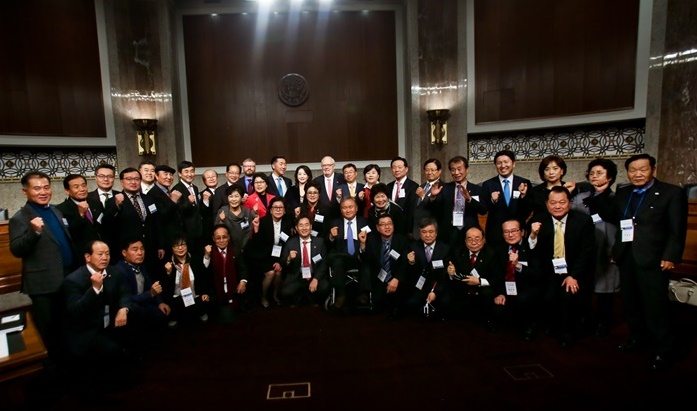
Action for Korea United representatives at the One Korea International Forum in Washington D.C. (Photo courtesy of Global Peace Foundation)
The creation of AKU came from hard won lessons learned during the Sunshine Policy of Kim Dae Jun and, later, Roh Moo-hyun. The liberal policy of engagement with the North seemed attractive on the surface, since it was a clear departure from the conservative Cold War outlook of previous presidents that sought the destruction of the Kim regime.
But in its implementation, this policy had no definable “endgame” and left many wondering what was the purpose and outcome of engagement. This lack of clarity doomed the Sunshine Policy to failure with subsequent dire consequences since it led to the funding of the North’s nuclear program.
As a Korean deeply committed to the unification of my homeland, it was a hard but clear lesson that the obstacles for unification did not reside with the North but with the South. The amazing opportunity to engage and lead the North towards unification was squandered in a malaise of token gestures, indecision and lack of clarity.
To make matters worse, many South Korean actors actively competed against each other to curry favor with the Kim regime, creating a “gold rush” atmosphere where the North played one off the other to their financial benefit. These lessons show that any future engagement with the North will require South Korea and the international community to be clear on the desired outcome of peaceful unification.
The need to create AKU came from these experiences. It is an effort to build clarity and unity in the South’s policy of engagement as well as to advocate a consensus building vision for the creation of a new nation, acceptable to all Koreans. That vision is the Korean Dream.
Toward a Post-Cold War Framework
Ladies and gentlemen, although the Cold War ended almost three decades ago, it is all too easy for government officials and policy experts to fall back into existing frameworks. This was the downfall of the Six-Party talks in which participants retreated all too easily into their old Cold War lineups.The divisive ideological worldview that shaped this region during the Cold War has given way to economic integration.
The divisive ideological worldview that shaped this region during the Cold War has given way to economic integration.
The geopolitics of the region have changed dramatically from 30 years ago. China, no longer, stands in the shadows of a larger Soviet empire and is currently driven by its own global ambition for hegemony in the region and the world.
Both China and Russia reformed their economies along western models and have engaged in trade with their former enemies, such as the United States, South Korea and Japan, at levels that were unheard of a decade, let alone three decades ago. Their foreign policy agendas for regional and global dominance make China and Russia geopolitical competitors, as much as rivals with the United States and its allies.

Other notable presenters at the One Korea International Forum opening day (left to right): Dr. Jai-Poong Ryu, President, One Korea Foundation; Hon. Jong-Kul Lee, Korean National Assembly, Minjoo Party; Mr. Greg Scarlatoiu, Executive Director,U.S. Committee for Human Rights in North Korea; Hon. Sang Jin Shin,Korean National Assembly, Liberty Korea Party (Photo courtesy of Global Peace Foundation)
The divisive ideological worldview that shaped this region during the Cold War has given way to economic integration. The global economy has merged the collective futures of formal rivals in Northeast Asia in unprecedented ways, since this region’s prosperity is fueled by the trade and domestic economies of the United States, China, Japan, South Korea and Russia. In this ever- changing environment, North Korea stands as the last vestige of the Cold War. It remains a serious impediment to the prosperity and, with its nuclear program, the security of the region.
It is in the interest of the United States and South Korea to engage other nations beyond the old Six Party lines that are beginning to have influence in Asia.
China and Russia are beginning to rethink their commitment to the North. In fact, the highly publicized state execution of Kim Jung Un’s uncle, Jang Song Taek, and later the assassination of his eldest brother, Kim Jung Nam, suggest strained relations between the North and China, as both men were known to be pro-Chinese members of the regime.
Unlike his grandfather and father, the younger Kim is alienating the North’s traditional Cold War allies and strengthening new alliances, with other rogue regimes like Iran. Therefore, it is in the interest of the United States and South Korea to engage other nations beyond the old Six Party lines that are beginning to have influence in Asia.
One such nation is India. During the Korean War, India remained a neutral party, under its Nonalignment policy, when UN forces intervened on the peninsula. Until recently, India was one of the North’s largest trading partners and a major food aid provider, with diplomatic and trade relations with both Koreas. Yet, little is mentioned about the strategic importance of India in dealing with the peninsular issue, especially in the policy circles in the US and the ROK.
In addition, important contributions can be made by other nations that have diplomatic relations with both South and North Korea. Mongolia for example, once firmly in the communist camp, has peacefully transitioned to a democratic system; it could serve as an example of what may be possible in North Korea.
Korean Independence Movement – The spirit from the past to waken the present and define the future
Ladies and gentlemen,
Korean patriots sought to free themselves from Japanese colonial rule, inspired by the section on self-determination in President Woodrow Wilson’s Fourteen Points, thinking there would be global support for their initiative. They created a Declaration of Independence that was proclaimed in peaceful rallies throughout the country in March 1, 1919. These gatherings mobilized more than two million Koreans and inspired other nations striving to unshackle the yoke of colonialism. Yet, tragically, their appeal fell on deaf ears among the victors in Paris and triggered increasingly harsh Japanese repression of Korean cultural identity.
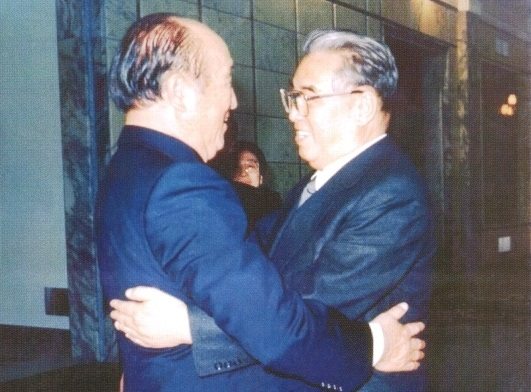
Rev. Sun Myung Moon (left) and Kim Il Sung (right) meet for the first time in North Korea. Dr. Hyun Jin P. Moon’s family has been involved in Korean independence and reunification for generations.
My family has been intimately involved in the Korean people’s struggle for freedom and I am proud of the role that they have played. My great grand uncle, Rev. Yoon-Guk Moon, was one of the founding architects of the declaration and movement for independence in Korea in 1919. My father the Rev. Dr. Sun Myung Moon was imprisoned for his involvement in this movement while studying in Japan. After liberation from Japan, he began his ministry in Pyongyang and was imprisoned for three years in a North Korean death camp in Hungnam, until he was freed by UN Forces in the fall of 1950.
Most importantly, he pioneered the opening to North Korea through his groundbreaking meeting with Kim Il Sung in 1991. During that historic meeting, my Father challenged the Juche Ideology upon which the Kim regime is built and emphasized the need to move towards the peaceful unification of the peninsula. Among the points raised in their informal discussions was that North Korea should not become a nuclear state. Kim Il Sung expressed an openness to closer relations with the South but the possibilities raised never bore fruit because of the innate divisions and the lack of an endgame vision within the South.
President Trump’s leadership in tackling the North’s nuclear ambitions and galvanizing global action and opinion against the Kim regime is bringing the crisis on the peninsula to a new level of international recognition and attention. For the first time in US history, America has an activist policy towards the North, making it clear that denuclearization of Korea is its main priority and that every option is left on the table. This position of strength and its emphasis on the crisis in Korea above all other foreign policy issues is a stark departure from every other administration going all the way back to the Truman administration.
Yet, to this day, many in the US still look at the Korean crisis through the lens of the Cold War. Many see the division of the peninsula as a larger struggle of opposing systems and ideologies. Ironically, that division was never the desire of the Korean people after liberation from Japan but the outcome of many failures in US foreign policy.
It failed to acknowledge the aspirations of an oppressed people during the March 1 independence movement of 1919, although it was the idealistic vision of President Wilson’s fourteen Points that inspired it. It allowed the Soviet Union to enter the war in the Pacific and eventually have a foothold on the peninsula, although it had defeated the Japanese Empire unilaterally.
It participated in the partitioning of the peninsula into zones of influence that later led to the two separate governments of South and North. Finally, it did not unite the peninsula during the Korean War and agreed to the current armistice along the 38th parallel. The current crisis on the peninsula is a direct result of historic American inaction and ignorance about the peninsula.
However, President Trump’s recent Asia tour suggests a renewed commitment to the region and, most of all, Korea. For most of US history, Korea has been an afterthought. Other geopolitical factors, issues and conflicts made the North Korean threat a tertiary issue throughout most of the second half of the 20th and the beginning of the 21st century.
Yet, with the North’s development of nuclear weapons and, now, its delivery systems to strike the US and its territories, the current administration is making the Korean crisis the centerpiece of its foreign policy.
Under this changing geopolitical context, South Korea will be hosting the 2018 Winter Olympic Games. Interestingly, 2018 marks the 30th anniversary of the Seoul Olympic Games where athletes from both the West and the Soviet Bloc met for the first time since the boycotts of the 1980 Games by the US and its allies and the boycotts of 1984 Games by the USSR and its allies.
In addition to the Olympics, that year marked the birth of South Korean democracy and the end of the military dictatorship, closing a painful chapter in the history of the South. The following year, 2019, marks the 30th anniversary of the fall of the Berlin Wall, the iconic symbol of the Cold War that separated the West from the Soviet Bloc.
But for Koreans, it marks the centennial of the Korean Independence Movement of 1919 that captured the aspirations of the Korean people throughout the 20th century. It reminds us of the, yet, unrealized hopes of those earlier independence pioneers and inspires us to constructive action to finally fulfill their ideals and dreams to create a unified, sovereign, independent nation that could be a model to the world for the betterment of all mankind.
One Korea Global Campaign: Creating synergies, making impact
That is why the Global Peace Foundation and Action for Korea United have launched the One Korea Global Campaign that seeks to spread the Korean Dream vision of unification and national destiny to all Koreans, in the South, North and the diaspora, throughout 2018.
The culminating event will be held in March of 2019 in Seoul, Korea, to commemorate the centennial of the Sam-il movement for independence. It will feature the Global Peace Convention and all affiliated projects and programs supporting the work of unification.
In addition, this initiative, through gatherings such as this forum, is promoting a new paradigm among academic and policy experts on Korea so that their respective governments can partner with the Korean people in their drive for self-determination and unification.
I am happy to report that prominent scholars of the International Advisory Council for Korean Unification and Northeast Asia Peace and Development are already developing a roadmap inspired by the Korean Dream. Yet, more of these kinds of developments are necessary if real change is to happen and this global initiative will provide the platform to make this possible.
In addition to engaging academic and policy circles, the One Korea Global Campaign will promote the Korean Dream through entertainment and cultural exhibitions. Already, the One K Concert series has become a regional phenomenon and we plan on expanding that initiative globally.
This project was launched in 2015 to commemorate the 70th year anniversary of Korean Liberation from Japan with a mega K-Pop concert in Seoul. With this event, a new genre of popular music was developed to engage the youth on the relevance of unification. The top entertainers of K-Pop and the most accomplished producer and composers in the industry contributed their creative efforts and time to this cause.
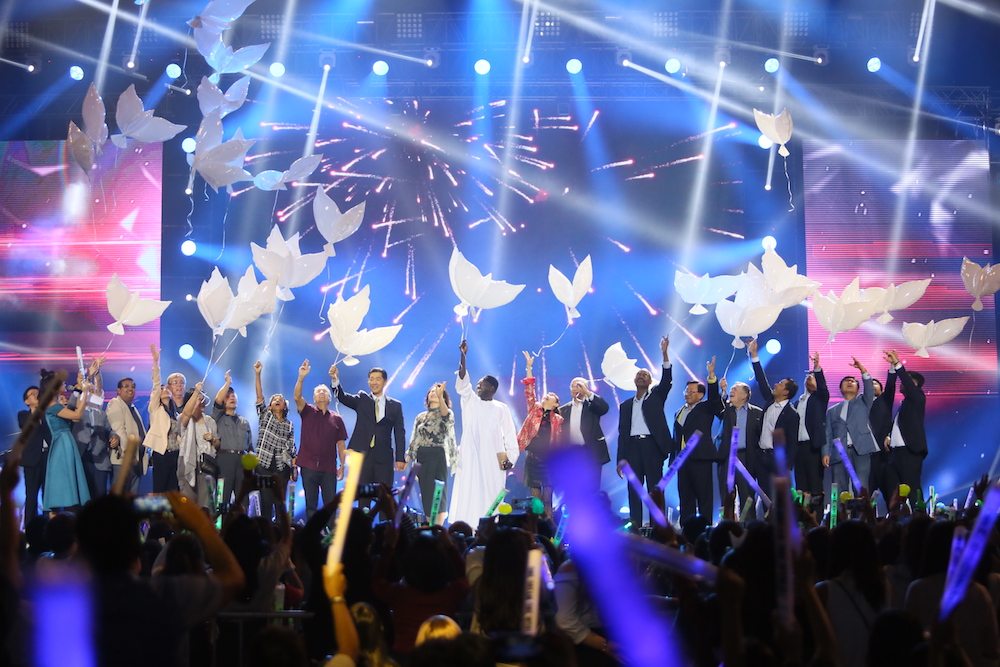
Dr. Moon joins other civic and faith leaders to pray for a peaceful unification of the Korean peninsula at the One K Global Peace Concert in Manila 2017. (Photo courtesy of Global Peace Foundation)
Just this past Spring, the One K Concert was held in Manila, Philippines, in conjunction with the Global Peace Convention. This concert drew more than 15 thousand youth and was the “talk of the town” in Manila, showing that the theme of unification was relevant not only to Koreans but to all Asians.
There, we were proud to debut to a global audience the new Korean Dream song written by Grammy award-winning producers, Jam and Lewis and performed by award winning artists Dami Im and Peabo Bryson. This song will be the anthem for unification to a new generation of young people around the world and will culminate in a major concert in Korea in March of 2019.
In addition to the One K Concert series, other cultural and education-based initiatives will make the unification agenda known to a wider global public. One such project is the creation and launching of a documentary film on the Korean Dream that presents the key themes of my book. It will especially highlight the importance of the Sam-il movement for independence not only to Koreans but all colonized people during that period of world history. The global premiere of this movie will coincide with all the events planned in Korea in March of 2019.
It is important to note that, although these larger projects will get much attention and will drive global interest, the vital work of the AKU partners in building grassroots consensus among the Korean people is where the proverbial “rubber meets the road.” Their contributions in humanitarian assistance, education, philanthropy, cultural arts, media and many others is the foundation on which this global initiative is built.
I would like to personally invite you and anyone interested in Korean unification to become a part of this historic One Korea Global Campaign, and together with GPF and AKU, to honor the 100th anniversary of the March 1st Movement at GPF’s Global Peace Convention on March 1st, 2019.
Conclusion
Ladies and gentlemen, we stand at an historical inflection point where history, circumstance and dreams unfulfilled are converging to create a “perfect storm” that can transform the landscape on the peninsula, northeast Asia and the world in profound ways.
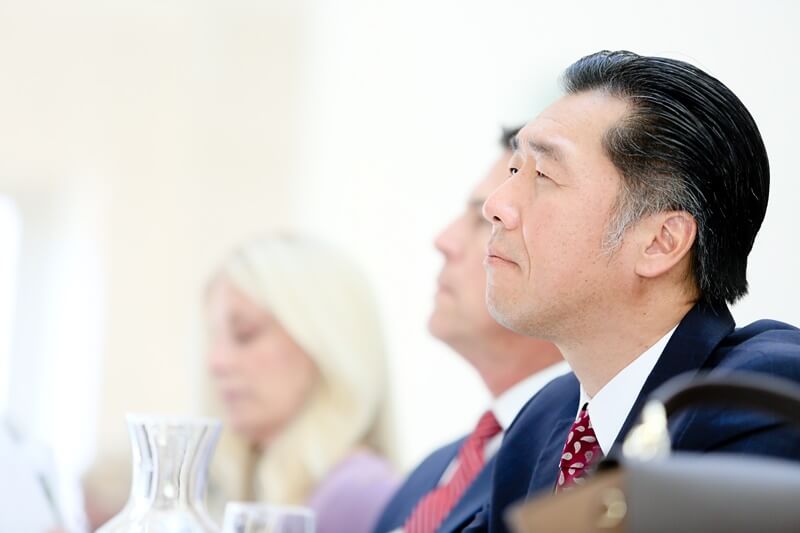
Dr. Hyun Jin P. Moon at the One Korea International Forum at the Ronald Regan International Trade Building in Washington D.C. (Photo courtesy of Global Peace Foundation)
The Korean Dream encapsulates the Hong Ik Ingan ideal that informed the aspiration of the Korean people to create a model nation that could realize their destiny to serve all humanity. This ideal was the DNA that became the foundation of our unique Korean history, culture and identity.
The division of the peninsula was an imposed foreign construct outside of this history, culture and identity. The change in US policy towards North Korea is building awareness that did not exist before.
This heightened awareness, especially when married to the One Korea Global campaign that GPF and AKU will be launching to commemorate the centennial of the Sam-il independence movement of 1919, will be a powerful force for change.
Given the anniversaries of historic milestones that represented friendship and freedom as well as dreams of self-determination and destiny in 2018 and 2019, respectively, I truly believe that we are at a historic providential moment when amazing things could happen.
Now is the time for far-reaching vision and bold action. Korea’s historical quest for one free, independent sovereign nation is within reach.
As a nation established on the ideal of benefitting all of humanity, Korea can stand as an example to the world. By surmounting the remnants of colonialism and Cold War divisions on the peninsula, the Korean people can attain their historical aspiration, and help others attain the global dream of “One Family under God.’
May God bless all of you and this historic work. Thank you very much.
Watch Dr. Hyun Jin P. Moon’s speech:
Download the pdf of the speech here.
For more speakers and information on the One Korea International Forum in Washington D.C. visit here.
Read Dr. Hyun Jin Preston Moon’s book: Korean Dream: A Vision for a Unified Korea

